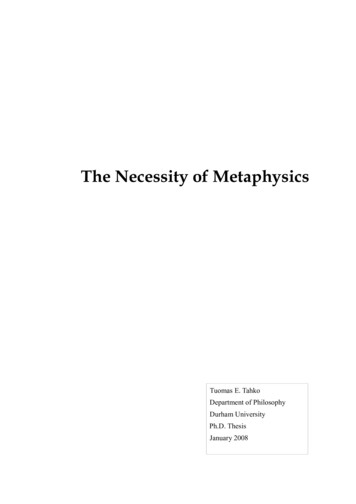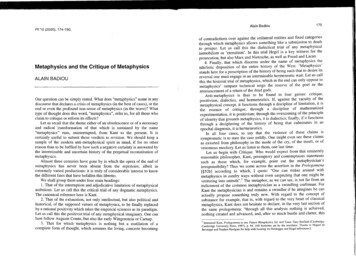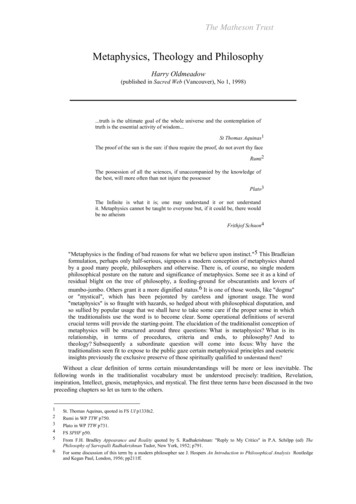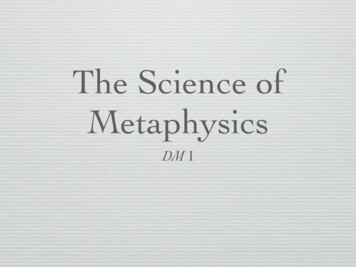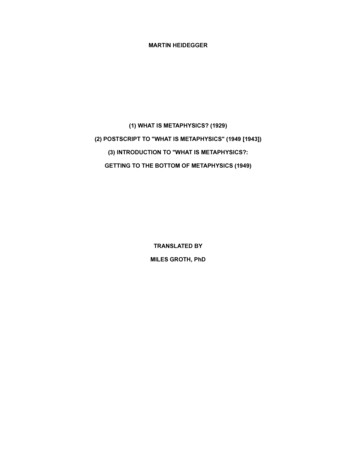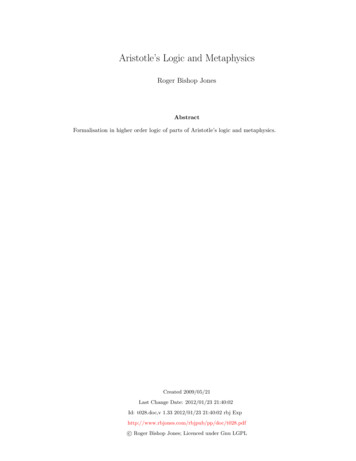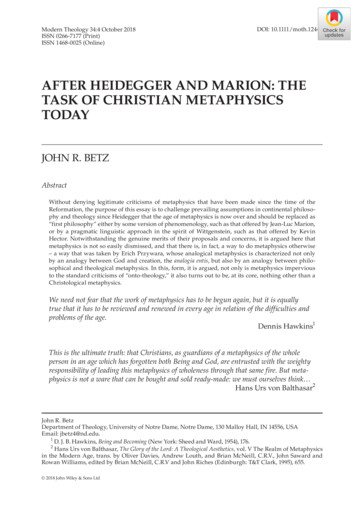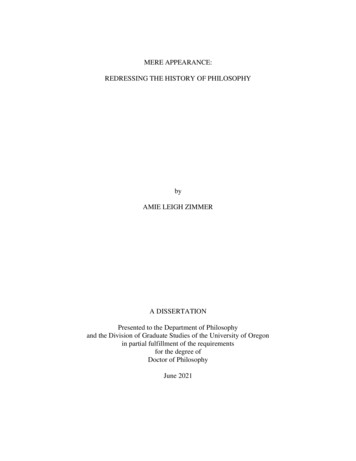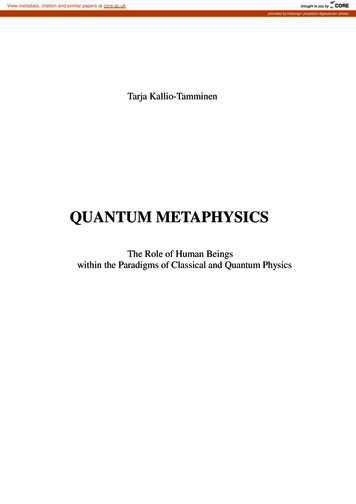
Transcription
View metadata, citation and similar papers at core.ac.ukbrought to you byCOREprovided by Helsingin yliopiston digitaalinen arkistoTarja Kallio-TamminenQUANTUM METAPHYSICSThe Role of Human Beingswithin the Paradigms of Classical and Quantum Physics
ISBN 952-10-1927-1Otamedia Oy 2004
2Tarja Kallio-TamminenQUANTUM METAPHYSICSThe Role of Human Beingswithin the Paradigms of Classical and Quantum PhysicsAcademic dissertation to be publicly discussed, by due permission of the Facultyof Arts at the University of Helsinki in auditorium XV, on the 11th of June, 2004 at12 o’clock.
3AbstractThis study investigates the question of why quantum mechanics still lacks a generally-acceptedinterpretation in spite of a century of serious deliberation. It is guided by the question whether quantummechanics requires a radical rethinking of the fundamental ontological and epistemologicalpresuppositions on which the current world-view, a conception of nature adopted at the turn of themodern era, is based.During recent centuries, physics has provided the main tools for the human enterprise ofunderstanding reality and our own role in this context. The classical paradigm of science was based on theidea of an objective material world which obeys strict deterministic laws. It was greatly affected byNewtonian mechanics whose differential equations were easy to interpret as describing the movement ofmaterial particles in space and time. Consequently, classical physics inspired a strong belief in adeterministic and clockwork-like universe, external to the human observer.In the quantum framework, the traditional space-time description of classical physics is overtaken bya more abstract description of state. The complex wave-function which resides in abstract multidimensional space is the most important term in the theory. It can never be directly observed and theinterpretation of this abstract entity has been a source of long controversy. Some researchers consider it tobe just a mathematical tool or instrument suitable for predicting the actual outcomes we can observe,others argue that the wave-function refers to some kind of transcendental quantum level. In any case, thewave-function is responsible for the non-local and statistical constitution of quantum physics which aredifficult to understand and explain within the mechanical and deterministic paradigm of classical physics.With the new description of state, some kind of indivisibility, internal spontaneity and change appear tobe a an unavoidable part of reality.The core of this study consists of the chapters investigating quantum theory and the debateconcerning its interpretation which has now continued for almost a century. Chapter 4 starts with a briefexplanation of the results of physical research that led to the creation of quantum theory, and describes themain features of the theory in common language avoiding mathematics and any further interpretation.Analysis of new features of the theory such as wave-particle dualism, non-locality, statistical predictionsand the measurement problem helps in understanding why quantum mechanics is difficult to perceivewithin the mechanistic-deterministic framework of classical physics. The theory seems to provideencouragement for the endeavour of reconsidering classical presuppositions concerning the nature ofreality. The Copenhagen interpretation of quantum mechanics actually proposed a radical reappraisal ofboth previous conceptions of reality and the role of humans, whereas many subsequent interpretationshave attempted to find a route back to the classical mechanical and deterministic framework bypostulating a variety of auxiliary hypotheses.This research material, i.e. the structure and interpretations of quantum mechanics, is studied againstthe background of previous conceptions of reality and the changes they brought about in western culture,in order to analyse and evaluate the credibility of the metaphysical presuppositions adopted by theclassical paradigm of science. The author argues that contrary to the common presuppositions of theclassical paradigm, the relationship between the human mind and nature may not be entirely one ofdetachment, and everything that happens may not be explainable by reducing individual events tomechanical interactions between particles.In the concluding chapter, she extends Niels Bohr’s philosophy of complementarity and outlines anonto-epistemological framework within which many of the apparent paradoxes of quantum mechanicscould be understood and solved. Even if profound revisions in the conception of reality are rare, thecommon world-view has, in western culture, changed radically in antiquity and at the turn of the modernera. The current change could be comparable in its extent, providing tools for a reconciliation of the ageold schism between natural science and humanistic concerns. By questioning the particle-mechanisticconception of matter, the new ontology offers a more fruitful starting point for understanding man’srelationship with nature. The non-local and statistical character of the state-description offers anopportunity to reconsider the subtle relationship between mind and matter. Mental states may be real andscientifically-approachable even if they are not totally identifiable with brain states. Human beings can bereconciled to the natural world without there being any need to restrain their unique character.
4ContentsPreface1. Introduction112. Formation of the Western Conception of Reality222.1. Natural philosophy in ancient times2.1.1 The Substance of Being2.1.2. Unchanging reality2.1.3. The Golden Age of Form2.1.4. The Significance of Antique Thought for Modern Science242.2. The Middle Ages and transcendental reality572.3. Birth of the modern scientific-technical paradigm2.3.1. The early pioneers of natural science2.3.2. Bacon and Descartes as shapers of the modern world-view2.3.3. Isaac Newton’s synthesis663. The mechanistic-deterministic conception of reality923.1. Fundamental ontological and epistemological presuppositions3.1.1. Mechanism3.1.2. Determinism3.1.3. Atomism and reductionism3.1.4. The objective nature of theoretical description953.2. The position of humans in mechanistic-deterministic reality3.2.1. The rise of materialism3.2.2. Freedom and free will1063.3. Philosophy in the mechanical and deterministic era3.3.1. Materialism versus idealism3.3.2. Empiricism versus rationalism3.3.3. Romantic natural philosophy in Germany3.3.4. Positivism and analytical theory of science1133.4. The crisis in the mechanical and deterministic way of thinking3.4.1. The limitations of classical mechanics in physics3.4.2. Crisis in the scientific portrayal of the human being3.4.3. The status of mechanical and deterministic laws3.4.4. The metaphysical foundation of theoretical constructions1383.5. Hypothetical-deductive development of the conception of reality3.5.1. The conception of reality as a cultural paradigm3.5.2. Transformation of the conception of reality3.5.3. Form and content in the thoughts of Niels Bohr3.5.4. The classical and quantum frames of reference154
54. Quantum mechanics and renewal of the conception of reality1734.1. The birth of quantum theory and its structure4.1.1. Early quantum phenomena4.1.2. The development of quantum theory4.1.3. Consequences related to quantum theory1734.2. New features connected with quantum mechanics4.2.1. The complex state vector, observables and properties4.2.2. Discontinuity and wave-particle dualism4.2.3. Uncertainty and Complementarity4.2.4. Unlocality and entanglement4.2.5. Indeterminism, irreversibility and the measurement problem1904.3. The interpretation of quantum mechanics as a manifestationof change in the conception of reality2154.3.1. The Copenhagen Interpretation: Reconstruction of theClassical Frame of Reference4.3.2. Niels Bohr’s Epistemological Lesson andthe Framework of Complementarity4.3.3. The Relationship between Complementarity and Realism,Pragmatism and Kantian Categories4.3.4. Later Attempts to Interpret Quantum Mechanics byreturning to the Classica Frame of Reference4.3.5. The concept of Consciousness in Discussons concerning Interpretation4.3.6. The Problem of Measurement and the Position of the Observer4.3.7. The Representation of Reality by Bohr and Einstein5. Conclusions5.1. Quantum mechanics requires a renewal of themechanistic-deterministic conception of nature5.1.1. Natural Philosophy and the growth of knowledge5.1.2. Revaluation of the role of the human beingReferences2872905.2. A New Onto-epistemological framework5.2.1.The abstract reality of state-functions5.2.2. Embodied representation2995.3. The Human being as an evolutionary agent5.3.1. Transcending the division between Subject and Object5.3.2. Quantum mechanics and the modelling of our internal states5.3.3. Psychophysical problem and free will revisited5.3.4. Observers and Actors – the Role of Consciousness310339
6PrefaceEven when I was at school, I found modern physics interesting. It appeared to me that thetheories of relativity and quantum mechanics were part of a search for fundamental and almostincomprehensible profoundities in nature which I wanted to understand better. My studies ofparticle physics and preliminary examinations of particle collisions in the bubble chamberimages at the Helsinki University Department of High Energy Physics offered new insights tothe basic natural symmetries controlling composite events: the wild spectrum of particles bornout of collisions could only come into being exactly as permitted by a few basic laws ofconservation. I learned to trust the precision of the physical method. I had not the slightest doubtthat all of the phenomena encountered in nature would, sooner or later, be explainable on thebasis of physical laws. Natural science appeared to have provided a much more credible andeven more comprehensive picture of the basis for reality than the imperfect and unsubstantiatedspeculations based on human nature provided by natural philosophers or mystics throughouthuman history.Little by little, however, I learned that the basic questions concerning the fundamental nature ofreality, the ones that interested me most, lacked clear answers. Courses in quantum mechanicstaught me how to solve wave functions in a variety of situations, but no-one explained their realmeaning. References to the role of theory as a mathematical instrument for prediction, ordiscourses on probability waves and the indeterminate nature of the world resulted in morequestions than answers. When I eventually resorted to the philosophy of science, I realised thatsimple answers simply did not exist. Almost a century of debate concerning the interpretation ofquantum mechanics had not even resulted in a consensus on whether there were problems withthe subject or not.In the Department of Philosophy, I came to realise that physical facts were of necessity based ontheory and more or less coloured by them, that theory had to be evaluated and examined in thelight of external and more general criteria, and that these criteria reflected fundamentalontological and epistemological beliefs which were neither final or immutable. When examiningand interpreting the basic physical theories, it is not even possible to be certain that either thelanguage or the logical arguments we employ represent reality as it truly exists. Since quantumtheory and the new elements associated with it can be interpreted in so many ways, I was nolonger surprised that Instrumentalism and Positivism had become so popular with pragmatic and
7practically-oriented physicists. Even so, the adoption of such relativistic attitudes struck me as aform of surrender, of being satisfied too easily. Why should we abandon the traditional realismconnected with physical research when quantum theory had confronted us with somethingendlessly fascinating – a treasure chest of the unexpected? If questions of interpretation remainedunanswered, we would lose a unique opportunity to gain a deeper understanding of the truenature of reality.Niels Bohr, famous for having developed the theory of the atom and generally considered to beone of the greatest physicists of the 20th century, was quite certain that quantum mechanics, justlike every deep and fundamental problem, carried with it its own solution: i.e. it forces us tochange our way of thinking.1 This starting point suited my own approach. I was quite certainthat through quantum mechanics, nature had taught us something which would alter ourapproach. The limitations in the metaphor of nature as a machine that was introduced at thebeginning of the modern era had become obvious, and the search had to begin for new modelsand ways of thinking, which could incorporate and make comprehensible the new features andinsights provided by quantum mechanics. The road to even a modest understanding was a longone. Before the pieces of the puzzle began to slip into place, I had to abandon many of the beliefsthat I held to be self-evident, and wade through several flimsy quagmires, both large and small.When I began my own research more than ten years ago, I used the principles of Realism andNaturalism to clarify what the long debate on the interpretation of quantum mechanics trulycontained and indicated. I carried with me the strong desire that a suitable interpretation wouldoffer a more fruitful starting point than those adopted previously for the investigation of humannature and its relationship to the external world. Both the ecological crisis and the significantcrumbling of cultural values are, in my opinion, closely connected with the modern era skills ofadopting a mechanical and objective view of nature. If humans cannot learn to see more clearlyboth their own position and the possibilities that nature offers, they are unlikely to acceptsufficient responsibility for shaping a decent future. Looking back, I can only repeat the oldadage – look and you will find.Initially, I approached the subject of questions connected with the interpretation of quantummechanics as broadly as possible. In addition to scientific papers by physicists and philosophers,quantum mechanics has spawned an unparallelled number of popular books and articles. My1Weisskopf 1990, 63.
8increasingly familiarity with the material revealed a multiplicity of starting points and interests:discussions, bewilderment, and argument. It was typical to speak of momentous and profoundchange: the need for it, a yearning for it, or its outright rejection. The discussion was fragmentedbetween many positions: a proponent of a traditional approach concerning a certainpresupposition could, in a different location, propose a radically new formulation. In somepieces, shaking the foundations of classical physics inspired fantastical arguments about paralleluniverses or ”active” information that guided particles. In others, a variety of magicalexplanations surfaced to explain observed phenomena, explanations that appeared impossiblewithin the context of classical physics. In fact, problems varied from one writer to the next insuch a manner that it was by no means easy to frame either common questions or even commonareas for which solutions were being sought.The philosophy of science addressed the discussion concerning models and reality at a moreabstract level. One end of the spectrum was represented by relativistic philosophy, according towhich ”any model is acceptable if it explains the facts”. This attitude was even moreunacceptable to me than the preceding ’naïve realism’, on the basis of which some physicistspostulated a variety of auxiliary hypotheses to allow them to hold on to the classical conceptionof reality. On the other hand, I also valued the down-to-earth approach adopted by physicists andviewed Relativism as having done good work in awakening us to our own freedom in creatingmodels and beliefs. At this point, however, I should reaffirm that even though we can freelypostulate a variety of models, we cannot close our eyes to their consequences. In our quest bytrial and error, reality dictates the boundaries.As my studies progressed, the Copenhagen interpretation, in particular the thoughts of NielsBohr, became my most important source of inspiration.2 I became certain that the basicpresuppositions of classical physics concerning both the external position of human beings andthe objective nature of physical description required radical revision. It is no longer possible toseparate the truth-seeking, knowing and sentient human being from the wholeness of naturewithout at the same time surrendering the basic objective of natural science, i.e. a deeperunderstanding of reality. The fact that these ontological and epistemological reflections resultedin a plunge into antiquity, and that the supposedly-dead ideas of Plato and Aristotle appeared to2I did my Master's Thesis in physics on the EPR paradox and in philosophy on the different interpretations ofquantum mechanics, see Kallio-Tamminen 1990. The thesis through which I earned my Licentiate degree (a degreeconferred by Finnish universities that stands between a Master's and a Doctor's degree) concerned Niels Bohr andhis reconsiderations of conceptions of physical reality, see Kallio-Tamminen 1994.
9me to offer new and significant material, was a reward for my journey that I could not havepredicted. To earn such a bonus, I am almost ready to do everything all over again.On many occasions during this, in some people’s opinion, perhaps over-brave attempt to producea comprehensive outline of the bases on which our conception of reality rests, I have beenfrustrated by the need to accept the shortage of time available for human beings so that I couldachieve a sufficiently deep insight into all the subjects that I am dealing with. I believe that moredetailed investigations by specialists in different areas could confirm many of my arguments, buteven if this does not happen, my work will not have been wasted if it awakens interest amongphysicists in the basic questions of philosophy, or results in increased understanding amongphilosophers of the significance of the facts produced by science. I also hope that, among myreaders, I can reduce the widely-disseminated fiction that the world is a somehow boring andwholly-known place in which the manner in which we spend our lives has no meaning.Now that this work is complete, I want to thank all the people who have helped and supportedme on my journey. I am especially grateful to my professor, Ilkka Niiniluoto, for his manyvaluable comments. Without his positive support, I might not have started this attempt to build abridge between the worlds of physics and philosophy. For his early comments on the direction ofmy work, I thank Professor Henry Folse, an expert in Bohrs’ philosophy. Emeritus ProfessorK.V.Laurikainen, sadly no longer with us, encouraged me in ways that cannot be overestimated.3Important for the development of many of my thoughts have been presentations to the Societyfor Natural Philosophy which he created, and which has subsequently been a source ofstimulating discussions. Many thanks for my achieving the final work are due to Professor EevaMartikainen, director of an interdiciplinary research project on ”Theology and NaturalSciences” financed by the Academy of Finland. She offered passage for a philosopher whostarted out from physics to a group which worked at the Department of Theology. In the summerof 1999, this project organised a seminar at which both Professor Kari Enqvist and Professor OlliKoistinen provided valuable feedback on my work. In the autumn of the same year, the projectmade it possible for me to spend one term as a visiting scholar at Cambridge University in theUK. The effect of this journey, the university library and bookshop on the final formulation ofwhat I believed to be an almost completed work was significant. Discussions with Professor JohnPolkinghorne and Jeremy Butterfield Ph.D introduced new perspectives on my subject matter. Iam especially grateful to Professor Rainer R. Zimmerman, who visited Cambridge at the time I3For more on this subject, see Kallio-Tamminen 1999.
10was there, and whose inspiring work in philosophy of physics offers challenging views for thefuture. Discussions with Paavo Pylkkänen Ph.D. and Inga R. Gammel Ph.D were also extremelystimulating. My husband Tapio Tamminen Ph.D, an anthropologist, has in many ways influencedmy thoughts concerning the formation of human cultures. For the English version of the text Iam grateful to Rick McArthur who in a splendid manner delved in to clarification of the subject.
111. IntroductionHumans have always attempted to improve their understanding of reality by explaining thephenomena encountered in their internal and external life. The foundations of the current worldview were laid down at the beginning of the modern era when René Descartes maintained thathis method of systematic doubt provided a basis for self-evident and certain knowledge.Descartes divided reality into two domains: res extensa and res cogitans. It was believed thatwith the help of theory, the thinking mind could discover the eternal universalities and truths thatcontrolled the world, even though understanding the connection between the subjective mind andthe external world of matter turned out to be difficult. Newtonian mechanics offered a firmfoundation for our modern scientific-technical culture based on natural sciences. Physics becamethe source for truthful knowledge concerning reality, and by exploiting its precise andsupposedly universal laws, humans have learned, step by step, to improve both theirunderstanding and control of the physical world’s conformity to laws. Also, it is increasinglycommon for approaches to subjective phenomena to be undertaken using methods that conformto the paradigm of classical physics (for example in neuro- and cognitive science), even thoughbuilding human actions and free will into a mechanical and deterministic framework is notwithout problems.In recent decades, the modern scientific-technical culture has become the target of increasingcriticism.4 Universal, timeless and absolute theoretical knowledge has increasingly been seen asinadequate in solving the concrete, practical and local problems in the middle of which peoplelive their lives and make their choices. Critics have also drawn on the authority of Aristotle. Thisgreat philosopher of antiquity was sensitive to both the conditions prevailing in specificsituations and to humanity’s many dependencies, and he warned against striving too hard forcertainty, inevitability or universality in things for which these are not natural.5 The physicswhich has been so powerfully changing our world-view is now more often viewed as holdingback necessary renewal and as a relic of single-dimensional thinking which cannot be expectedto make a significant contribution to the creation of a new operational strategy for mankind. Asconsequence of this criticism, the traditional schism between natural science and humanism thatis based on Cartesian dualism has become increasingly acute.4For philosophers and environmentalists, see e.g. Feyerabend, Kuhn, and Toulmin, von Wright, Capra, Devlin,Skolimowski, and Habermas.5Toulmin 1990, 70, 75.
12As I see it, profound change in ways of operating and thinking requires us to overcome thisantagonism: to reassess our conception of reality in a way which takes account of humans andtheir significance in the world. Humanists who emphasise the role of humans usually fail tomention that the strongest challenge to the correctness of mechanistic-deterministic ways ofthinking has come from within physics itself, when modern physics collided with the limitationsof earlier ways of thinking at the beginning of the 1900s. This crisis was overcome bydeveloping new and better theories. In light of these, it seems possible that the attempt to finduniversal and exact knowledge which started at the beginning of the modern era had in factprovided tools which will also permit improved modelling and understanding of the humanbeing, our history- and context-based behaviour – without the requirement to artificially truncateeither human creativity or humanity’s many dimensions.In particular, the almost century-long debate concerning the interpretation of quantummechanics, the basic theory behind modern physics, is an indication of deep crises in theunderstanding of reality. The complexity of this discussion and the conflicting conclusionsreached indicate how quantum mechanics collides with fundamental philosophical problems.From the viewpoint of quantum mechanics, the whole of the western ontological-based approachto natural philosophy is considered to be mistaken, but on the other hand new ontological modelshave also been constructed.6 Certainty has been sought via mathematical language and its ageold Platonic forms and symmetries, while ways of explanation which use the Atomistic andReductionist explanations of Democritus and ordinary language have been viewed as inadequateto capture holistic and constantly-changing features of reality. 7The quantum mechanics created in the 1920s required a radical change of paradigm in physicalresearch. Visualisable Newtonian mass-point mechanics was replaced by an abstractmathematical formalism which, just like classical mechanics in its own time, can be applied tosolve a huge variety of new research targets. Modern physical theories based on quantummechanics are well known for their precise predictions, but no-one can define the basis of theirpredictive ability in a certain way. In spite of decades of discussion, there is no interpretation ofquantum theory which enjoys general acceptance. Physicists have realized that final solutions to67Petersen 1968.Heisenberg 1985, 45-54.
13many ontological and epistemological questions have not yet been found.In the debate concerning interpretation, the strong influence of classical particle-mechanisticthinking on the modern world-view and approach to reality has become the subject of increasingcriticism. In addition to questions concerning how ideas of determinism, reductionism andlocalisation shape our understanding of matter, the debate about interpretation also concerns thetraditional conception that the subject and the object are independent of one another: can anexternal observer who is carrying out experiments make objective observations without havingan influence on the studied system because of his own actions, and can the theories he constructsbased on empirical observations and reason corresponds to reality’s actual structure?Questions dealing with the interpretation of quantum mechanics belong primarily to the domainof the philosophy of science. This precise branch of philosophy, which began to bloom in the1900s, specialises in problems concerning the basic presuppositions and ways of thinkingadopted in scientific enquiry, and in the explication, analysis, and formulation of imprecise,ambiguous or only implicitly-adopted views.8 Quantum mechanics has already offeredphilosophers of science copious quantities of material in connection with debates concerning thenature and character of laws, but my proposition is that quantum mechanics could also shedfurther light on fundamental questions such as the nature, objectives and results of science, andproblems associated with the growth and truthfulness of knowledge. If the discussion about theinterpretation of quantum mechanics can be seen as a manifestation of a profound change ofparadigm in how we conceive reality, a preliminary hypothesis of this study, analysis of thediscussion could highlight the nature and methodological role of the presuppositions andhypotheses that have traditionally been the province of scientific philosophers. Also, thediscussion regarding interpretation is easier to follow and analyse when seen in the context oflong-term research programmes and paradigms.Even though the philosophy of science has been dealing with the intricate problems associatedwith the nature and interpretation of scientific theory and its relationship to reality for a longtime, some scientific commentators awakened by the profound puzzles in the current state ofphysics have simply deduced that the problems with the interpretation of quantum mechanicsmean the end of science, or at least a limit on its applicability, since in the debate even the8Niiniluoto 1980, 22, 32-33.
14scientific method and its objectives have been questioned.9 A less-dramatic approach is to viewthe crisis raised by quantum mechanics as evidence of the ending of the current scientificphilosophical paradigm. It was Niels Bohr’s belief that quantum mechanics demonstrated thelimitations in the traditional space-time description of classical physics. The mechanistic anddeterministic image of nature formed at the beginning of the modern era has provided thebackground for all research carried out in that era, but its Reductionist and Meristic10methodology cannot necessarily explain all aspects of reality. It is quite possible that portrayingthe whole of reality in the form of a model which assumes that the world consists of distinct andindividual parts and research objects cannot succeed. If quantum mechanics is able to reveal thatthe earlier mechanistic-deterministic paradigm has limitations, the theory can also provideindispensable material for developing a new and more successful way of handling andconceiving reality.In the twentieth century, modern physics presented radical challenges to earlier modes ofthinking and its mathematical tools served to overcame previous limitations, but themetaphysical presuppositions which provide the background to the practice of science have not,even between physicists, changed as radically as Niels Bohr, for example, hoped they would. Atthe beginning of the 20th century, Bohr and Einstein engaged in an e
3.4.4. The metaphysical foundation of theoretical constructions 3.5. Hypothetical-deductive development of the conception of reality 154 3.5.1. The conception of reality as a cultural paradigm 3.5.2. Transformation of the conception of reality 3.5.3. Form and content in the thoughts of Niels Bohr 3.5.4. The classical and quantum frames of reference

